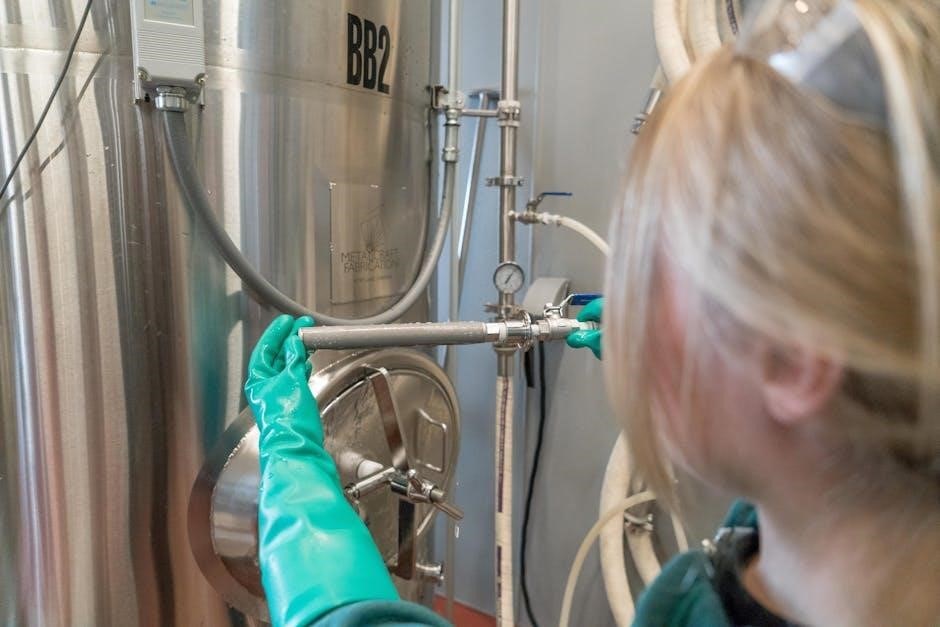Valve guide honing is a precision machining process used to restore worn valve guides, ensuring proper valve stem sealing and engine performance. It involves using specialized tools to polish the guide surfaces, preventing oil leakage and maintaining combustion efficiency. Regular honing is essential for extending engine lifespan and optimizing its operation.
1.1 What is Valve Guide Honing?
Valve guide honing is a machining process that restores worn valve guides to their proper dimensions. It involves using specialized tools, such as diamond-coated stones, to smooth and reshape the guide surfaces. This procedure improves the surface finish and geometry, ensuring better alignment and sealing of the valve stem. By honing, engines maintain optimal performance, reduce oil leakage, and prevent potential damage from worn guides. It’s a precise technique that enhances engine efficiency and longevity.
1.2 Importance of Valve Guide Maintenance
Proper valve guide maintenance is crucial for engine performance and longevity. Neglected guides can lead to oil leakage, reduced efficiency, and increased emissions. Symptoms like blue smoke from the exhaust and excessive oil consumption often indicate worn guides. Regular honing or replacement ensures tight valve stem sealing, preventing these issues. Maintaining valve guides is essential for optimal engine operation, fuel efficiency, and minimizing long-term repair costs. It directly impacts engine health and reliability.

Causes of Valve Guide Wear
Valve guide wear is primarily caused by engine oil degradation, heat and friction, and contamination or debris; These factors lead to excessive wear over time, affecting engine performance and efficiency.
2.1 Engine Oil Degradation
Engine oil degradation is a primary cause of valve guide wear. Over time, oil breaks down, losing its lubricating properties and forming deposits. This leads to increased friction and heat, accelerating guide wear. Without proper lubrication, the valve stem and guide experience excessive stress, causing premature wear and potential oil leakage. Regular oil changes and using high-quality lubricants can help mitigate this issue and extend the life of valve guides.
2.2 Heat and Friction
Heat and friction are significant contributors to valve guide wear. The engine’s high operating temperatures cause metal expansion, altering the fit between valve stems and guides. Friction from continuous movement generates heat, exacerbating wear. Over time, this leads to a looser fit, allowing oil to seep into the combustion chamber and burn, causing blue smoke from the exhaust. Proper cooling and lubrication are essential to minimize this wear.
2.3 Contamination and Debris
Contamination and debris significantly accelerate valve guide wear. Dirt, carbon deposits, and metal particles can enter the guides, causing abrasive damage. Over time, this leads to increased clearance between the valve stem and guide, allowing oil to leak into the combustion chamber. This contamination often results in blue smoke from the exhaust and decreased engine performance. Regular cleaning and proper filtration are critical to preventing such issues.

Symptoms of Worn Valve Guides
Common symptoms include blue smoke from the exhaust, increased oil consumption, and rough engine performance. These issues arise from oil leaking into the combustion chamber due to worn guides.
3.1 Blue Smoke from Exhaust
Blue smoke from the exhaust is a clear indicator of worn valve guides. This occurs when engine oil leaks into the combustion chamber and burns, producing a distinctive blue hue. The smoke is often more noticeable during acceleration or when the engine is under load. It may also appear in the morning when the engine is cold. Persistent blue smoke suggests significant wear, requiring immediate attention to prevent further engine damage.
3.2 Increased Oil Consumption
Worn valve guides often lead to increased oil consumption, as engine oil seeps into the combustion chamber. This results in frequent oil top-ups and higher maintenance costs. Over time, excessive oil loss can damage engine components and reduce performance. If left unchecked, it may cause severe engine damage, emphasizing the need for timely valve guide honing or replacement to restore proper sealing and prevent further issues.
3.4 Rough Engine Performance
Worn valve guides can cause rough engine performance by allowing engine oil to enter the combustion chamber. This results in poor combustion efficiency, leading to misfires, reduced power, and uneven engine operation. Mechanics often diagnose this issue during a road test or by inspecting the manifold with a camera, revealing excessive oil buildup around the guides. Addressing this issue promptly is crucial to prevent further engine damage and maintain smooth performance.

The Honing Process
Valve guide honing involves using specialized tools, like honing stones and precision equipment, to precisely restore worn guides. This process ensures proper valve stem sealing and minimizes oil leakage.
- Requires specialized honing tools.
- Restores surface finish and alignment.
- Ensures proper valve stem operation.
4.1 Tools and Equipment Needed
To perform valve guide honing, specialized tools are required. These include a valve guide hone tool, honing stones, a precision guide alignment tool, and a drill press for stability. Additional equipment such as torque wrenches, lubricants, and cleaning solvents are essential to ensure accuracy and prevent damage during the process. Proper tools are critical for achieving a smooth, even surface finish.
4.2 Step-by-Step Honing Procedure
First, inspect the valve guides for wear or damage. Attach the honing tool to the drill press and set the desired RPM. Insert the tool into the guide, applying light pressure while moving it up and down. Use a dial indicator to ensure proper alignment. Repeat the process until the surface is smooth. Finally, clean the area with a solvent and apply lubricant to the honed surface.
Installing New Valve Guides
Install new valve guides by pressing or threading them into place, ensuring proper alignment and seating for optimal engine performance and minimal oil leakage;
5.1 When to Replace Valve Guides
Valve guides should be replaced when excessive wear is detected, often indicated by symptoms like blue smoke from the exhaust, increased oil consumption, or rough engine performance. If ignored, worn guides can lead to severe engine damage. Inspect and replace them when these signs appear to prevent further deterioration. Proper replacement involves using specialized tools and techniques to ensure a precise fit and optimal performance.
5.2 Proper Installation Techniques
Proper installation of valve guides requires specialized tools to ensure accurate alignment and fit. Use a valve guide installer to press in the new guides, ensuring they are seated correctly. Align the guides with the engine’s specifications to maintain proper valve train performance. Clean the area thoroughly before installation to prevent contamination. Inspect the guides after installation to confirm they are securely fitted and functioning as intended.

Benefits of Valve Guide Honing
Valve guide honing enhances engine efficiency, reduces oil leakage, and prevents severe damage from wear. It restores proper valve function, minimizing future repairs and extending engine lifespan.
6.1 Improved Engine Efficiency
Valve guide honing enhances engine efficiency by ensuring tight seals between valve stems and guides. This reduces oil leakage and prevents contaminants from entering combustion chambers. Improved sealing allows the engine to maintain proper compression, leading to better fuel efficiency, increased power output, and smoother operation. These benefits collectively contribute to optimal engine performance and reliability, making honing a critical maintenance procedure for engine longevity.
6.2 Reduced Oil Leakage
Valve guide honing significantly reduces oil leakage by restoring the surface finish of worn guides. This process ensures tighter seals between valve stems and guides, preventing oil from entering combustion chambers or the exhaust system. With reduced leakage, engines experience lower oil consumption, decreased emissions from burned oil, and improved overall performance. Regular honing helps maintain engine health and efficiency, preventing costly repairs down the line.
Common Mistakes to Avoid
Improper tool usage and ignoring guide alignment can lead to uneven surfaces, affecting engine performance and increasing repair costs. Always follow proper honing guidelines.
7.1 Improper Tool Usage
Using incorrect or worn-out honing tools can lead to uneven valve guide surfaces, reducing the effectiveness of the process. This can cause improper sealing, increased wear, and higher oil consumption. Always use high-quality, properly calibrated tools designed for valve guide honing to ensure precise results. Improper tool usage can also damage the guides further, leading to costly repairs. Adhere to manufacturer guidelines to avoid such mistakes.
7.2 Ignoring Guide Alignment
Ignoring guide alignment during valve guide honing can lead to improper seating of the valve stems, resulting in increased oil consumption and reduced engine efficiency. Misalignment can cause uneven wear on the valve guides and stems, potentially leading to more severe engine damage over time. Proper alignment ensures optimal engine performance and extends the lifespan of the valve train components thereby.
Cost and Time Considerations
Valve guide honing costs vary depending on tools and labor. DIY kits are affordable but time-consuming, while professional services offer quicker results at higher prices.
8.1 DIY vs. Professional Service
DIY valve guide honing can save costs but requires specialized tools and mechanical expertise. Professionals offer faster, high-quality results, reducing downtime and ensuring accuracy. DIY may risk improper alignment or damage, while professional services guarantee reliability and warranty. Choose based on your skill level, time availability, and desired outcome. Proper tools and experience are crucial for success in either approach.
8.2 Average Cost of Valve Guide Repair
Valve guide repair costs vary, typically ranging from $300 to $1,500 per engine, depending on severity and labor rates. DIY kits may cost $100-$300, while professional services, including parts and labor, can exceed $1,000. Additional charges for machining or replacement of guides may apply. Costs also depend on engine type, shop rates, and geographic location. Always seek a detailed estimate from a qualified mechanic for accurate pricing.
Regular valve guide maintenance and honing are crucial for preventing wear and improving engine efficiency. Invest in proper techniques and tools to future-proof your engine performance effectively.
9.1 The Importance of Regular Maintenance
Regular maintenance is vital for extending engine longevity and ensuring optimal performance. Valve guide honing helps restore worn surfaces, improving efficiency and reducing oil leakage. Addressing wear early prevents costly repairs and maintains reliable engine operation. Consistent upkeep ensures proper valve function, minimizing the risk of future issues. Prioritizing maintenance supports overall engine health and reliability, making it a critical practice for vehicle owners.
9.2 Future-proofing Your Engine
Valve guide honing is a proactive step in safeguarding your engine’s future. By addressing wear early, you prevent major repairs and ensure optimal performance. This process enhances durability, reducing the risk of oil leakage and promoting efficient combustion. Regular honing invests in your engine’s longevity, ensuring it runs smoothly for years. It’s a cost-effective way to maintain reliability and prevent premature wear, protecting your engine from potential failures down the road.
